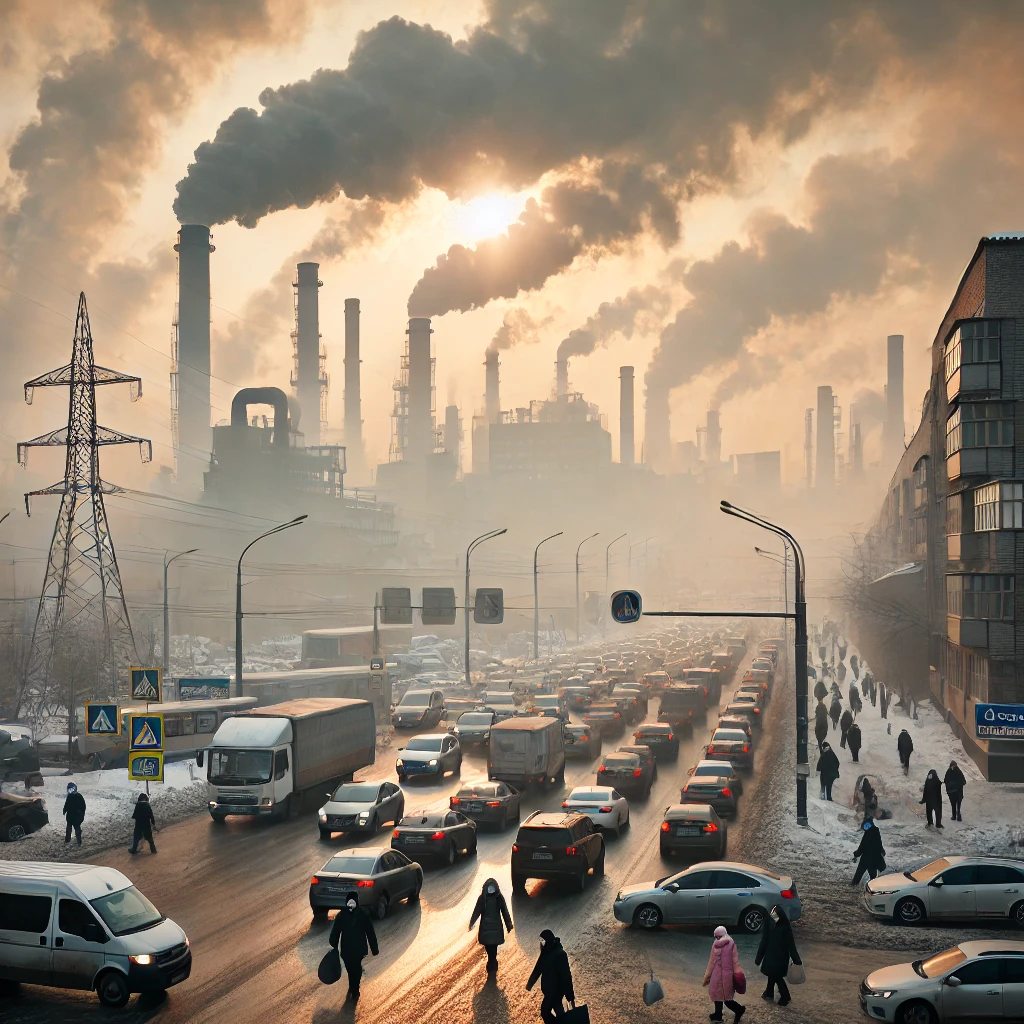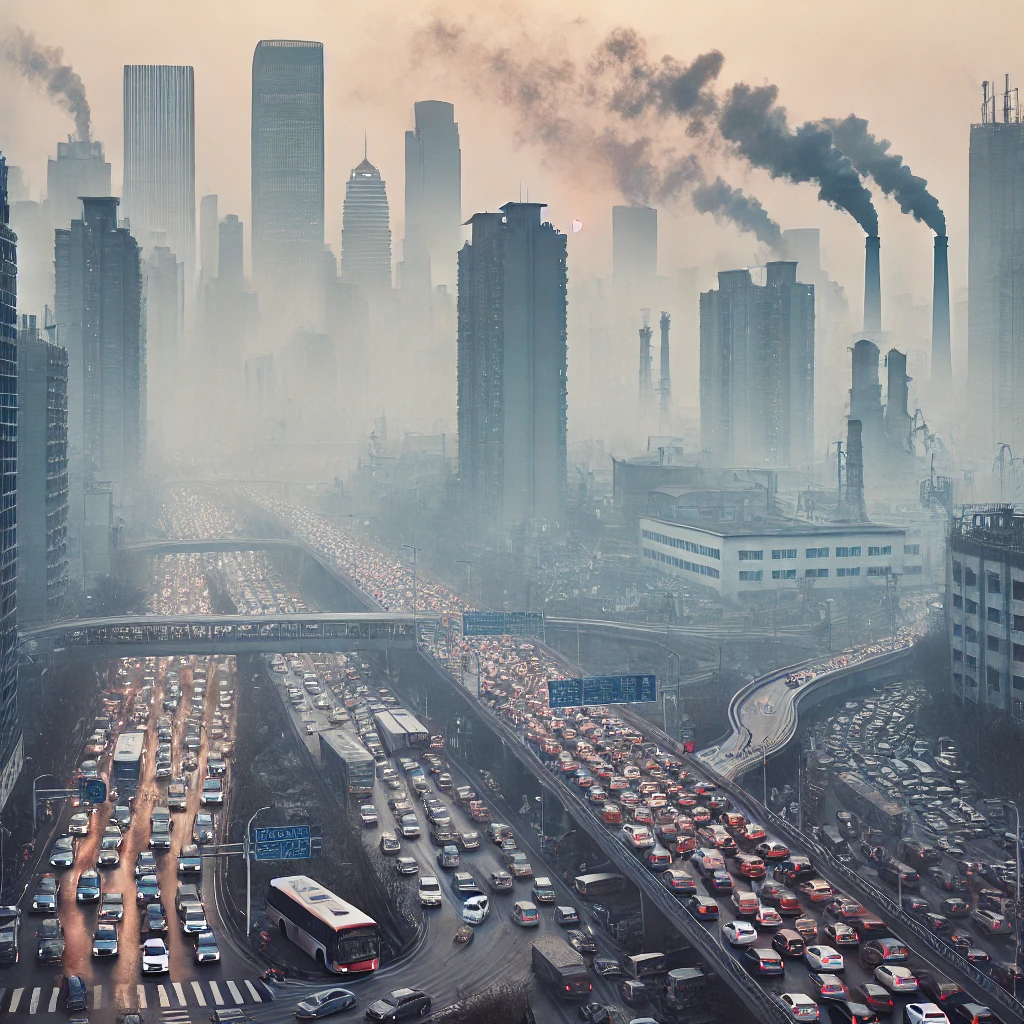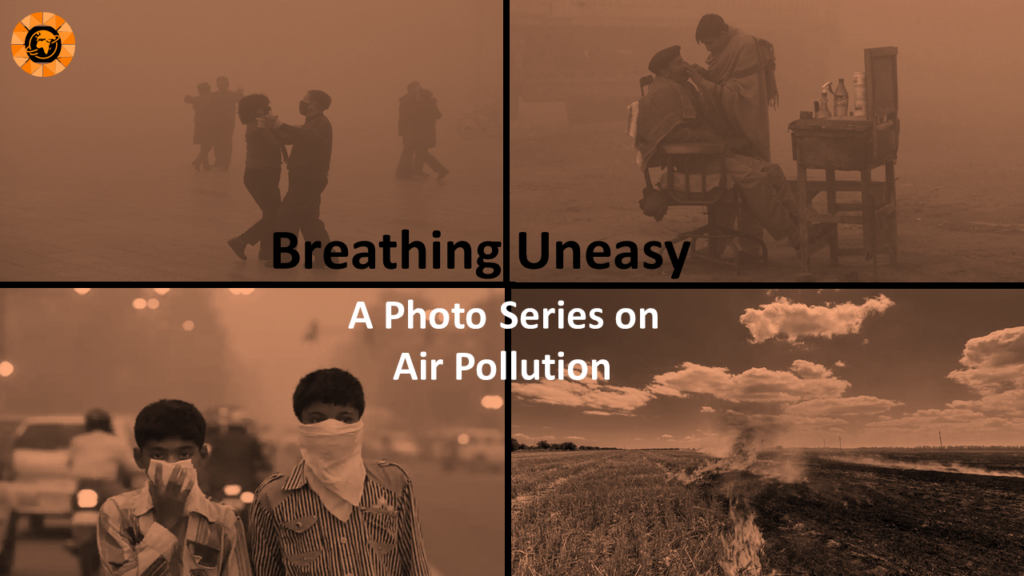While our society grapples with problems and issues that demand our immediate attention, the devastating impact of air pollution keeps growing quietly. According to the WHO, seven million people die every year from exposure to fine particles in polluted air. The casualties caused by air pollution are not distributed uniformly across the world. More than 90% of air pollution-related deaths occur in low- and middle-income countries, mainly in Asia and Africa1. Ignoring a problem like air pollution has a devastating impact on economic growth and quality of life of various population groups.
For many people, it is images and not statistics that form the most visceral reminders of social realities. This article seeks to highlight the gravity of distress caused by a lack of clean air in the world today, by means of authentic images and descriptions.
- Dancing in the dark
Source: NBC News
The above image, captured in early 2017, shows people wearing masks while dancing at a square enveloped by heavy smog. The image was captured during daytime in Fuyang, China but everything is enveloped by smog so dense that it appears to be twilight. This photo represents how our public spaces and safety are both threatened by the air we are forced to breathe.
Smog is a mixture of pollution like fine particulate matter (PM), ground level ozone and fog. Local factory emissions, pollutants from households contribute greatly to smog, which floats around with the wind. Cities like Fuyang, Shanghai, Delhi and Los Angeles experience health damaging smog each year. As per Mayo Clinic, outdoor activities like working out during smog is detrimental to heart and lung heath and is particularly dangerous for people with co-morbidities and the elderly. It can worsen the health of those with asthma, diabetes and cardiovascular issues.
- Everyday Life in Lahore

Source: BBC
This photo was taken in January of 2019, on an early morning in Lahore, Pakistan. Here, we can see winter fog mix with pollutants to produce toxic smog, but people continue to go about performing routine tasks. In developing nations like India, Pakistan and China, the problem is air pollution is more serious due high population density and uncontrolled urbanization in cities. The image also represents a harsh reality of impact: not everyone suffers the repercussions of pollution in the same manner.
Airborne contaminants from cars, factories, wood fires and other sources cause a quarter of fatal heart attacks and strokes, 29% of lung cancer deaths and 43% of mortalities from chronic obstructive pulmonary disease, a WHO report shows2. Those who suffer from these ailments tend to be members of the working classes and economically disenfranchised communities. People belonging to the working classes are often continuously exposed to roadside traffic pollutants, work in factories and use smoke producing wood stoves. Thus, they are the main victims of air pollution related deaths.
- The Children of New Delhi
Source: Hindustan Times
The image shows children covering their face to protect themselves from air pollution during the winter of 2018, in New Delhi, India.
Perhaps what is most disheartening about the poverty of air quality is the effect it has on young children. A particularly concerning WHO study determined that 93% of children under the age of 15 (which is approximately 1.8 billion children) breathe polluted air that compromises healthy development and overall well being. In 2016 alone, 600,000 children died3 due to acute lower respiratory infections, attributed to polluted air.
Children are uniquely vulnerable to air pollution as their lungs continue to develop throughout adolescence. Developing lungs are less effective in fighting off pollution related respiratory problems. While doctors and parents encourage children to play outdoors and indulge in physical activities; children who are more active end up inhaling more polluted outdoor air than adults4. Air pollution is not just a compromise of their health, but it also prevents kids from enjoying a physically fit and active childhood.
- Dangerous Cityscape

Source: AFP
The image, taken in December 2017, captures the bustling activities in Cairo, Egypt. Cairo is one of the most polluted cities in the world, with average particulate matter (PM) 10 levels higher than the WHO guidelines. Inhabitants of cities like Cairo have to battle industrial and vehicular pollution everyday. Each year thousands of people migrate towards polluted megacities like New Delhi, Cairo, Dhaka and Tokyo for better employment opportunities. While people with greater wealth commonly acquire property in suburban areas to enjoy a clean and green environment, an increasing number of poor people are forced to actively disregard concerns about their own health to secure employment.
- Innovating Change – A Corporate Initiative

Source: (Left to Right) IKEA, Down To Earth Magazine
The first image, released by IKEA in 2019, captures IKEA’s collection called FÖRÄNDRING, which is Swedish for ‘change’. This is a product collection made of rice straw. The second image shows the common practice of stubble burning from Punjab, India, and was captured in 2016. Crop burning emits enormous amounts of black carbon that contributes to the melting of Himalayan ice.
How are the two images related? In 2018, IKEA instituted its ‘Better Air Now’ initiative which seeks to turn crop residue like stubble into sustainable products. This has given birth to the FÖRÄNDRING collection that includes rice-straw made baskets, bowls and rugs. This productive use of agricultural byproducts is currently encouraging rice growers to practice sustainable farming and not burn stubble. IKEA is looking into turning more types of crop residue into bioenergy, packaging materials and usable products in the future.
| What does the photo series reflect? Decent quality air is not a want or desire that people should have to work towards, in order to fulfil. It is a basic human need that must be fulfilled to enjoy a healthy life. Clean air has historically been included in the economic category of a ‘pure public goods’. The two features of a pure public good are non-rivalry and non excludability. Simply put, non rivalry implies that one person’s access to a good does not reduce someone else’s ability to enjoy the same good. The other element, non-excludability, means that no group of people can be prevented from enjoying the good. We have long held that one person’s ability to breathe fresh air does not reduce the quality of air for others to enjoy. Additionally, no one can be prevented from breathing in air. But on closer inspection, there are multiple facts that reveal a consistent inequity in access to clean, safe and breathable air. Belonging to a certain geographical area, wealth bracket and community can determine the level of access to good quality air that one will get to breathe. Reversal of years of environmental pollution is not an easy to achieve goal. But meaningful partnerships and corporate willingness like that of IKEA are reflective of the change that is still possible today. An overwhelming number of global corporate giants have amassed profits by making use of lax environmental laws in a number of countries. Yet, air pollution is now creating economic barriers for corporate wealth. In 2013 alone, air pollution related deaths cost the global economy about US$225 billion in lost labor income5. The number of deaths have only gone up since then. Corporate social responsibility reflects a company’s legal and moral responsibility towards the community and the environment. There are a number of ways in which corporations can fulfil this responsibility according to what best suits their vision and operations. We at OneBarrow help our corporate partners examine their waste and production generation process. Quantifying air pollution generated during the manufacturing process allows corporations to develop a clear inventory for major pollutants. Meaningful data aids the development of coherent CSR policies that help reduce pollution from operations. Additionally, we enable companies to contribute towards social programmes and carry out targeted community outreach. It is well understood that humankind’s use of natural resources is progressing at an unsustainable rate at the moment. Corporations contribute to this burden with their immense carbon footprints, but the resources at their disposal also indicates their ability to contribute to positive change. It is time they understand they use this potential to drive monumental change. |
Riya Shankar Sharma
Content Writer, OneBarrow
************
References
- “9 out of 10 people worldwide breathe polluted air, but more countries are taking action.” WHO. May 2, 2018. Accessed July 23, 2021. https://www.who.int/news/item/02-05-2018-9-out-of-10-people-worldwide-breathe-polluted-air-but-more-countries-are-taking-action.
- “Air Pollution Deaths Cost Global Economy US$225 Billion.” Text/HTML. World Bank. September 8, 2016. Accessed July 23, 2021. https://www.worldbank.org/en/news/press-release/2016/09/08/air-pollution-deaths-cost-global-economy-225-billion.
- “Air Pollution Inequality Widens between Rich and Poor Nations.” 2018. The Guardian. May 1, 2018. http://www.theguardian.com/environment/2018/may/01/air-pollution-inequality-widens-between-rich-and-poor-nations.
- “Children and Air Pollution.” Accessed July 23, 2021. American Lung Association. https://www.lung.org/clean-air/outdoors/who-is-at-risk/children-and-air-pollution.
- “More than 90% of the World’s Children Breathe Toxic Air Every Day.” WHO. October 29, 2018. Accessed July 23, 2021. https://www.who.int/news/item/29-10-2018-more-than-90-of-the-worlds-children-breathe-toxic-air-every-day.
















